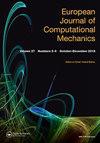Analysis of Water Seepage Mechanism and Study on Mechanical Properties of Highway Tunnel Based on Fluid-Structure Coupling
IF 1.5
Q3 MECHANICS
引用次数: 0
Abstract
Shaoguan was hit by a extremely heavy rainstorm, and the mountain water catchment of Dabaoshan Tunnel in the southern section of Beijing Hong Kong Macao Expressway in Guangdong increased sharply. Due to the rapid rise of groundwater level, water and mud gushed at ZK141+227 of Dabaoshan, and serious water seepage occurred in other areas, bringing soil into the tunnel, which seriously hindered the safe passage of the tunnel. According to the on-site investigation of water and mud gushing, it was found that there were branches sandwiched in the mud gushing out, and at the same time, it was found that there was water leakage at the foot of some walls where drainage holes were added. Based on the fluid structure coupling mechanism, the seepage mechanism of highway tunnels was deeply explored, and the mechanical properties of tunnels under seepage were analyzed through experimental data and numerical simulation. The experimental results show that under the action of seepage, the stress distribution of the tunnel lining changes, and the phenomenon of local stress concentration is obvious. When the seepage pressure reaches 3.5 MPa, cracks appear in the tunnel lining, with a total of 5 cracks. The distribution of cracks is closely related to the seepage field. The numerical simulation further reveals the interaction mechanism between the seepage field and the tunnel structure, confirming the influence of the seepage field on the stability of the tunnel lining. When the seepage pressure increases to 4.0 MPa, the displacement change rate of the tunnel lining reaches 0.3 mm/m, and the maximum lining stress is 15.7 MPa. The purpose of this study is to propose a maintenance plan for highway tunnels to improve their safety. Consider the impact of seepage on tunnel structure and adopt effective waterproofing and drainage design. Further research on the seepage mechanism and tunnel mechanical properties is recommended to provide more reliable theoretical support for engineering applications.基于流固耦合的公路隧道渗水机理分析与力学性能研究
韶关遭受特大暴雨袭击,京港澳高速公路广东南段大巴山隧道山体汇水量急剧增加。由于地下水位急剧上升,大巴山 ZK141+227 处出现涌水、涌泥现象,其他地区也出现严重渗水,并将泥土带入隧道,严重阻碍了隧道的安全通行。根据对涌水、涌泥的现场勘察,发现涌泥中夹有树枝,同时发现部分墙脚加设排水孔处有渗漏水现象。基于流体结构耦合机理,深入探讨了公路隧道的渗流机理,并通过实验数据和数值模拟分析了隧道在渗流作用下的力学性能。实验结果表明,在渗流作用下,隧道衬砌应力分布发生变化,局部应力集中现象明显。当渗流压力达到 3.5 MPa 时,隧道衬砌出现裂缝,共有 5 条裂缝。裂缝的分布与渗流场密切相关。数值模拟进一步揭示了渗流场与隧道结构之间的相互作用机理,证实了渗流场对隧道衬砌稳定性的影响。当渗流压力增加到 4.0 MPa 时,隧道衬砌的位移变化率达到 0.3 mm/m,衬砌的最大应力为 15.7 MPa。本研究的目的是提出公路隧道的维护计划,以提高隧道的安全性。考虑渗水对隧道结构的影响,采用有效的防水和排水设计。建议进一步研究渗流机理和隧道力学性能,为工程应用提供更可靠的理论支持。
本文章由计算机程序翻译,如有差异,请以英文原文为准。
求助全文
约1分钟内获得全文
求助全文

 求助内容:
求助内容: 应助结果提醒方式:
应助结果提醒方式:


